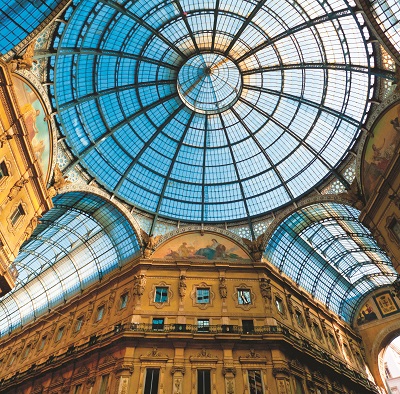Of the thousands of new hotel rooms built around Milan in anticipation of the EXPO 2015 crowds, 98 of the most elegant can be found at the gracious Palazzo Parigi (1 Corso de Porta Nuova, Tel: 39-02625-625. www.palazzoparigi.com ) in the cobblestoned Brera district. The Palazzo has quickly become one of the most desired lodgings for attendees of the city’s world-renowned fashion weeks and furniture design fairs.
Built on the site of a former bank headquarters, the three-year-old Palazzo could easily pass for 100 years old with its marble columns, gilded railings, and sculptural crystal lobby chandelier. Astonishing for a hotel with so few guest rooms is the amount of common space, including a luxuriously appointed lounge garden, where it’s easy to sink into a comfortable armchair and while away a late afternoon, sipping an Aperol spritz from the bar and gazing out at the adjacent garden through sunsplashed floor-to-ceiling windows.
For more modestly priced lodgings, consider the contemporary StarHotels E.ch.o, (4 Viale Andrea Doria, Tel: 39-02-67891. www.starhotels.com/en/our-hotels/echomilan), which surprises with a lovely garden of its own. While you’re here, indulge with a visit to the Palazzo Parigi’s Grand Spa. A couple hours in the gorgeous indoor pool area with its rough tiled floors and Moorish design feels like a quick trip to Morocco in the midst of urban Italy. (Be aware that sauna, steam, and whirlpool areas are co-ed, with swimsuits required).
To feel like an up-and-coming Milan design insider, and to catch a glimpse of some real ones, you’ve got to go old school and do a weekday lunch at the Brera district’s unassuming, hole-in-the-wall Latteria San Marco (24 Via San Marco, Tel: 390-2659-7653) recommended to me by local bon vivant Fabrizio Fedeli, publisher at Zero, the Italian counterpart to Time Out magazine. Once a corner store, this tiny, cluttered no-reservations restaurant has been run by the same married couple since 1965. They serve simple, robust Italian dishes (menus are in Italian only, but servers speak some English) like a bracing salad of puntarelle (a crisp, slightly bitter chicory) with anchovies, and spaghetti tossed with copious amounts of red pepper and lemon zest. This is lipsmacking authenticity.

Glass Dome of Galleria Vittorio Emanuele by Mario Savoia
There’s a new way to experience one of Milan’s oldest attractions, the skylit passages of the Galleria Vittorio Emanuele II. Completed in 1877, the glass-vaulted shopping arcades between the Piazza del Duomo and Piazza del Scala have long been among the city’s most popular tourist draws. Just last May, however, after several years of planning and construction, a trail of metal catwalks has been opened to the public, allowing visitors to walk along the rooftops and view the gallery skylights from above. Highline Galleria (2 Via Silvio Pellico, Tel: 39-02-4539-7656. www.highlinegalleria.com) affords unusual views of the Duomo spires and panoramic perspectives on the city as a whole. It’s a photo opportunity akin to the rooftop vistas of Paris from the Pompidou.
While EXPO 2015 was a passing fancy for Milan, a long-lasting boom in another underdeveloped part of the city is likely to be generated since the May 2015 opening of the Fondazione Prada (2 Largo Isarco, Tel: 390-2566-2611. www.fondazioneprada.com) complex. Twenty minutes southeast of Milan’s center by train, an old distillery has been transformed by one of Italy’s preeminent fashion houses into a highly experiential compound for modern art appreciation. Combining four existing buildings with three new structures (including a nine story museum tower and a high end restaurant which is still under construction), the very design of the campus forces comparison and contrast of the old and the new.
Walking through the low-slung featured galleries, smartly curated exhibitions invite visitors not only to think about individual pieces of art, but about how arrangement and presentation can affect their meaning.
A cinema and performance space offer programming that integrates with the exhibitions and the cheerful museum café, Bar Luce, is designed by Director Wes Anderson (The Grand Budapest Hotel, Darjeeling Express), whose famous eye for eccentric detail is clearly at work in his pink and aqua mash-up of a 50’s American diner and 19th-century Italian architecture.
Fondazione Prada is likely to do for this fallow quarter of Milan what the Guggenheim did for Bilbao, helping further raise the city’s global profile.


